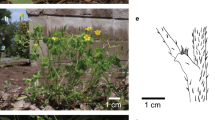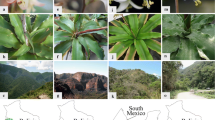Abstract
In Gondwanic Discaria, phenotypically intermediate individuals exist between Discaria chacaye (G. Don) Tortosa and Discaria articulata (Phil.) Miers, and between D. chacaye and related Ochetophila trinervis (Gillies ex Hook. & Arn.) Poepp. ex Miers. We studied phenology, pollinators, parental crossability, morphological features, and variation patterns on neutral markers. Intermediates occur wherever parental taxa are sympatric or in close proximity. Flowering was synchronous in D. chacaye and D. articulata for 2 weeks. They also shared three to six pollinator species (depending on site). O. trinervis, which flowered later, occasionally overlapped with D. articulata, with which it shared two pollinators. Germinable seeds were obtained from hand pollinations only from crosses with D. articulata as paternal parent and D. chacaye as maternal parent. Sequencing of chloroplast DNA revealed only two haplotypes. One occurred in D. articulata, D. chacaye, and their intermediates, and the other in O. trinervis and its intermediate with D. chacaye. Only pure parentals had diagnostic alleles by isozymes, whereas intermediates mainly showed those of D. chacaye. Our results confirm intrageneric hybridization between D. chacaye and D. articulata, and intergeneric hybridization between D. chacaye and related O. trinervis.

Similar content being viewed by others
References
Premoli AC (1996) Allozyme polymorphisms, outcrossing rates, and hybridization of three Nothofagus species. Genetica 97:55–64
Aagesen L (1999) Phylogeny of the tribe Colletieae. Bot J Linn Soc 131:1–43
Aagesen L, Medan D, Kellermann J, Hilger HH (2005) Phylogeny of the tribe Colletieae (Rhamnaceae)—a sensitivity analysis of the plastid region trnL-trnF combined with morphology. Plant Syst Evol 250:197–214
Ackermann M, Achatz M, Weigend M (2008) Hybridization and crossability in Caiophora (Loasaceae subfam. Loasoideae): are interfertile species and inbred populations results of a recent radiation? Am J Bot 95:1109–1121
Acosta MC, Premoli AC (2010) Evidence of chloroplast capture in South American Nothofagus (subgenus Nothofagus, Nothofagaceae). Mol Phylogenet Evol 54:235–242
Agresti A (1996) An introduction to categorical data analysis. Wiley, New York
Arbetman M, Premoli AC (2011) Oldies (but goldies!): extracting DNA from cryopreserved allozyme homogenates. J Hered 102:764–769
Arnold ML (1997) Natural Hybridization and Evolution. Oxford University Press, Oxford
Barulenga M, Stölting KN, Salzburger W, Muschick M, Meyer A (2006) Sympatric speciation in Nicaraguan crater lake cichlid fish. Nature 439:719–723
Chaia EE, Valverde C, Wall LG (2006) Local adaptation of Frankia isolates to different Discaria (Rhamnaceae) host species growing in Patagonia. Curr Microbiol 53:523–528
Devoto M, Medan D, Montaldo NH (2005) Patterns of interaction between plants and pollinators along an environmental gradient. Oikos 109:461–472
Devoto M, Medan D, Roig-Alsina A, Montaldo NH (2009) Patterns of species turnover in plant-pollinator communities along a precipitation gradient in Patagonia (Argentina). Austral Ecol 34:848–857
Dumolin S, Demesure B, Petit RJ (1995) Inheritance of chloroplast and mitochondrial genomes in pedunculate oak investigated with an efficient PCR method. Theor Appl Genet 91:1253–1256
Ellstrand NC, Whitkus R, Rieseberg LH (1996) Distribution of spontaneous slant sybrids. Proc Natl Acad USA 93:5090–5093
Gore PL, Potts BM, Volker PW, Megalos J (1990) Unilateral cross-incompatibility in Eucalyptus: the case of hybridization between E. globulus and E. nitens. Aust J Bot 38:383–394
Kameyama Y, Toyama M, Ohara M (2005) Hybrid origins and F1 dominance in the free-floating, sterile bladderwort, Utricularia australis f. australis (Lentibulariaceae). Am J Bot 92:469–476
Kellermann J, Medan D, Aagesen L, Hilger HH (2005) Rehabilitation of Ochetophila Poepp. ex Endl. (Rhamnaceae: Colletieae). N Z J Bot 43:865–869
King JN, Dancik BP (1983) Inheritance and linkage of isozymes in white spruce (Picea glauca). Can J Genet Cytol 25:430
Knobloch IW (1972) Intergeneric hybridization in flowering plants. Taxon 21:97–103
Marchelli P, Gallo LA (2004) The combined role of glaciation and hybridization in shaping the distribution of genetic variation in a Patagonian southern beech. J Biogeogr 31:451–460
Medan D (1991) Reproductive phenology, pollination biology, and gynoecium development in Discaria americana (Rhamnaceae). N Z J Bot 29:31–42
Medan D (1993) Breeding system and maternal success of a perennial hermaphrodite, Discaria americana (Rhamnaceae). N Z J Bot 31:175–184
Medan D (2003) Reproductive biology of the Andean shrub Discaria nana (Rhamnaceae). Plant Biol 5:94–102
Medan D, Aagesen L (1995) Comparative flower and fruit structure in the Colletieae (Rhamnaceae). Bot Jahrb Syst 117:531–564
Medan D, Devoto M (2005) Reproductive ecology of a perennial outcrosser with a naturally dissected distribution. Plant Syst Evol 254:173–184
Medan D, Schirarend C (2004) Rhamnaceae. In: Kubitzki K (ed) The families and genera of vascular plants. VI. Flowering plants–Dicotyledons: Celastrales, Oxalidales, Rosales, Cornales, Ericales. Springer, Heidelberg pp 320–338
Medan D, Basilio AM, Devoto M (1999) Biología reproductiva de Discaria chacaye (Rhamnaceae: Colletieae) en el Parque Nacional Lanín, Neuquén. Resúmenes, 19 Reunión Argentina de Ecología, Tucumán, April 1999
Medan D, Kellermann J, Aagesen L, Hilger HH (2009) The validity of Ochetophila Poepp. ex Endl. (Rhamnaceae: Colletieae). Feddes Rep 120:218–220
Mitton J, Linhart Y, Sturgeon K, Hamrick J (1979) Allozyme polymorphisms detected in mature needle tissue of ponderosa pine. J Hered 70:86–89
Morrell P, Rieseberg LH (1998) Molecular tests of the proposed diploid hybrid origin of Gilia achilleifolia (Polemoniaceae). Am J Bot 85:1439–1453
Murphy RW, Sites JW Jr, Buth DG, Haufler CH (1996) Proteins: isozyme electrophoresis. In: Hillis DM, Moritz C, Mable BK (eds) Molecular systematics. Sinauer Associates, Sunderland, pp 51–120
Nei M (1978) Estimation of average heterozygosity and genetic distance from a small number of inividuals. Genetics 89:583–590
Park KR, Pak JH, Seo BB (2003) Allozyme variation in Paraixeris: a test for the diploid hybrid origin of Paraixeris koidzumiana (Compositae). Bot Bull Acad Sin 44:13–122
Petit RJ, Bodénès C, Ducousso A, Roussel G, Kremer A (2003) Hybridization as a mechanism of invasion in oaks. New Phytol 161:151–164
Premoli AC, Mathiasen P, Acosta MC, Ramos VA (2012) Phylogeographically concordant chloroplast DNA divergence in sympatric Nothofagus s.s. How deep can it be? New Phytol 193:261–275
Ranker C, Haufler H, Soltis PS, Soltis DE (1989) Genetic evidence for allopolyploidy in the neotropical fern Hemionitis pinnatifida (Adiantaceae) and the reconstruction of an ancestral genome. Syst Bot 14:439–447
Raven PH (1976) Systematics and plant population biology. Syst Bot 1:284–316
Reyes MF, Gobbi ME, Chaia EE (2011) Reproductive ecology of Ochetophila trinervis in northwest Patagonia. Funct Plant Biol 38:720–727
Rieseberg LH, Ellstrand NC (1993) What can molecular and morphological markers tell us about plant hybridization? Crit Rev Plant Sci 12:213–241
SIB (2012) Sistema de Información de Biodiversidad, Administración de Parques Nacionales http://www.sib.gov.ar. Accessed 19 Feb 2012
Soltis DE, Soltis PS (1989) Allopolyploid speciation in Tragopogon: insights from chloroplast DNA. Am J Bot 76:1119–1124
Stebbins GL (1950) Variation and evolution in plants. Columbia University Press, New York
Stebbins GL (1959) The role of hybridization in evolution. Proc Am Phil Soc 103:231–251
Taberlet P, Gielly L, Pautou G, Bouvet J (1991) Universal primers for amplification of three non-coding regions of chloroplast DNA. Plant Mol Biol 17:1105–1109
Tamura K, Dudley J, Nei M, Kumar S (2007) MEGA4: molecular evolutionary genetics analysis (MEGA) software version 4.0. Mol Biol Evol 24:1596–1599
Thompson JD, Higgins DG, Gibson TJ (1994) CLUSTAL W: improving the sensitivity of progressive multiple sequence alignment through sequence weighting, position-specific gap penalties and weight matrix choice. Nucleic Acids Res 22:4673–4680
Tortosa RD (1983a) El género Discaria (Rhamnaceae). Bol Soc Argent Bot 22:301–335
Tortosa RD (1983b) Una especie polimorfa de Discaria: D. chacaye (G. Don) comb. nov. (Rhamnaceae) y sus híbridos presuntivos. Parodiana 2:79–98
Tortosa RD (1989) El género Colletia (Rhamnaceae). Parodiana 5:279–332
Tortosa RD (1992) El complejo Retanilla-Talguenea-Trevoa (Rhamnaceae). Darwiniana 31:223–252
Tortosa RD (1999) Rhamnaceae. In: Zuloaga FO, Morrone O (ed) Catálogo de las plantas vasculares de la República Argentina II (Monographs in systematic botany from the Missouri botanical garden 74) pp 974–981
Tortosa RD, Aagesen L, Tourn GM (1996) Morphological studies in the tribe Colletieae (Rhamnaceae): analysis of architecture and inflorescences. Bot J Linn Soc 122:353–367
Williams EG, Rouse JL (1988) Disparate style lengths contribute to isolation of species in Rhododendron. Austral J Bot 36:183–191
Wood TE, Nakazato T (2009) Investigating species boundaries in the Giliopsis group of Ipomopsis (Polemoniaceae): strong discordance among molecular and morphological markers. Am J Bot 96:853–861
Wright GT, Briggs JD (2000) Population survey and notes on the ecology of the Leafy Anchor Plant (Discaria nitida) in New South Wales. Unpublished report. New South Wales National Parks and Wildlife Service, Hurstville
Wu W, Zhou R, Huang Y, Boufford DE, Shi S (2010) Molecular evidence for natural intergeneric hybridization between Liquidambar and Altingia. J Plant Res 123:321–239
Acknowledgments
Arturo Roig-Alsina and Rocío Fernández-Vaquero helped with insect identification. Lone Aagesen provided us with two unpublished trnL sequences of D. chacaye × D. articulata. Alicia Basilio, María Fernanda Reyes, Manuel de Paz, Mariano Devoto, and Norberto H. Montaldo helped with fieldwork. Norberto Bartoloni helped with statistical analyses. Comments by Mariano Devoto and three anonymous reviewers helped to improve a previous draft. Financial support was granted by Consejo Nacional de Investigaciones Científicas y Técnicas (Argentina) to D.M. and A.C.P. [PIP 5704].
Author information
Authors and Affiliations
Corresponding author
Electronic supplementary material
Below is the link to the electronic supplementary material.
Rights and permissions
About this article
Cite this article
Medan, D., Arbetman, M., Chaia, E.E. et al. Interspecific and intergeneric hybridization in South American Rhamnaceae-Colletieae. Plant Syst Evol 298, 1425–1435 (2012). https://doi.org/10.1007/s00606-012-0646-0
Received:
Accepted:
Published:
Issue Date:
DOI: https://doi.org/10.1007/s00606-012-0646-0




